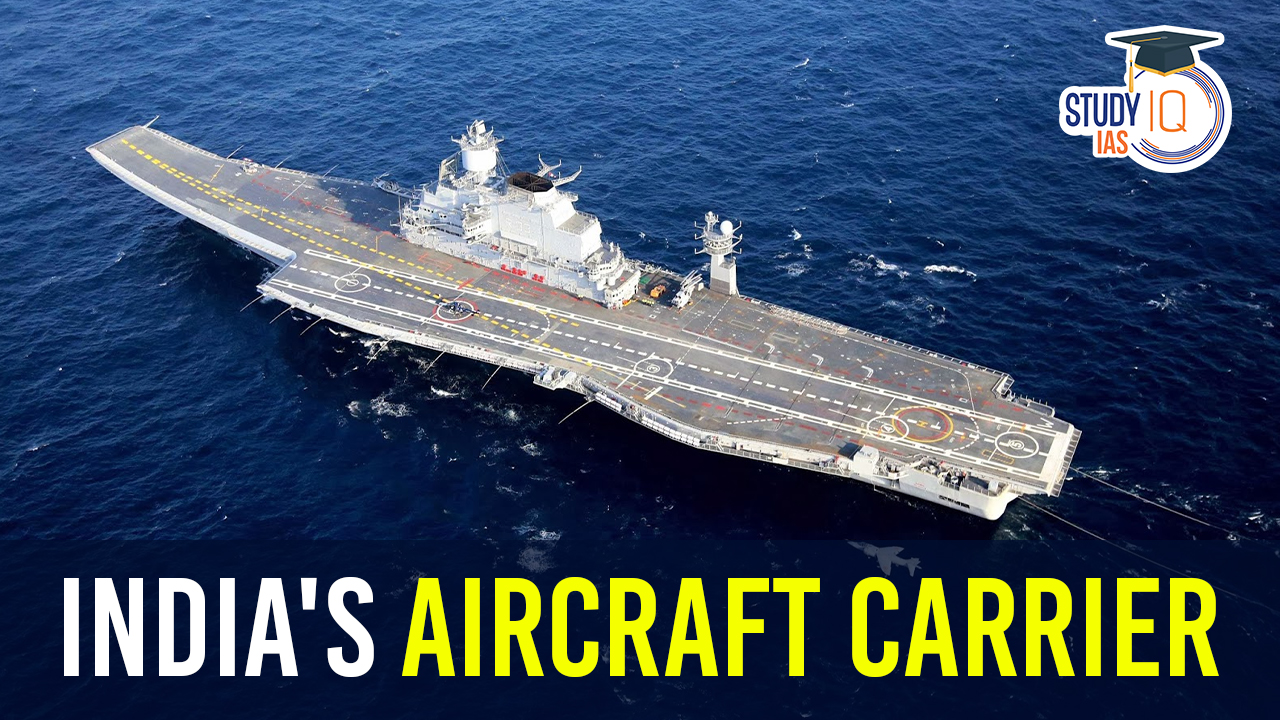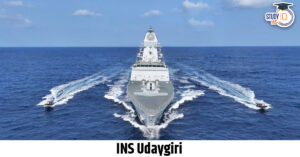Table of Contents
India is one of the few nations globally to operate aircraft carriers, symbolizing strategic naval strength, maritime dominance, and self-reliant defense capabilities. The Indian Navy currently operates two aircraft carriers — INS Vikramaditya and INS Vikrant, with a third, INS Vishal, in the pipeline. These warships are floating airbases that provide India with immense power projection in the Indian Ocean Region (IOR) and beyond.
India’s Aircraft Carrier
India currently boasts two aircraft carriers: INS Vikramaditya and INS Vikrant. The latter, commissioned in September 2022, was acquired on July 28, 2022, while INS Vikramaditya was ordered on January 20, 2004, and launched on December 4, 2008, following extensive refurbishment valued at $2.35 billion. Despite its shorter flight deck (262m vs. 284m), INS Vikrant is 2 meters wider (62m vs. 60m) and features a more streamlined island structure than INS Vikramaditya. India’s naval ambitions include a third carrier resembling INS Vikrant and a second indigenous carrier, reinforcing its maritime capabilities and global presence.
History of India’s Aircraft Carrier
Right from its Independence, India was well aware of the need for aircraft carriers to establish itself as a blue water navy. Since the sixties, the Indian Navy has had the unique distinction of operating all variants of aircraft launch and recovery systems.
INS Vikrant (R11) – India’s First Aircraft Carrier
INS Vikrant, originally named Hercules, was purchased from Britain in 1957 and commissioned in 1961. It was India’s first aircraft carrier and played a crucial role in the 1971 war, leading to the birth of Bangladesh. In 1984, it transformed into a Vertical/Short Take-Off and Land (V/STOL) carrier, housing the modern Sea Harrier aircraft. After 36 years of service, it was decommissioned in 1997.
INS Viraat – Over 30 Years of Service
Originally commissioned as HMS Hermes in 1959, INS Viraat served in the British Royal Navy before being acquired by India in 1986. It played a significant role in Operation Jupiter in Sri Lanka, the 1999 Kargil War, and numerous joint exercises. INS Viraat was decommissioned in 2017, having logged over 5.8 lakh nautical miles during its service, making it a pivotal asset in India’s maritime history.
India’s Aircraft Carrier INS Vikramaditya
INS Vikramaditya, formerly Russia’s Admiral Gorshkov, was integrated into the Indian Navy on November 16, 2013, becoming India’s largest vessel. This state-of-the-art aircraft carrier boasts impressive specifications, including a length of over 285 meters, a width of 60 meters, and 23 decks towering 60 meters high. It accommodates a “Floating City” of over 1,600 personnel and carries 30 aircraft, ranging from MiG 29K fighters to Kamov helicopters. The MiG 29K serves as the primary offensive platform, providing a substantial boost to India’s maritime strike capabilities. Advanced launch and recovery systems, such as the LUNA and DAPS, ensure smooth aircraft operations.
| Specification | Details |
| Name | INS Vikramaditya |
| Commissioned | November 16, 2013 |
| Aircraft Complement | MiG-29K Fighters, KM 31 AEW Helicopters, Multi-role Seakings, Utility Chetaks |
| Length | Over 285 meters |
| Width | 60 meters |
| Decks | 23 decks, scaling a height of 60 meters |
| Personnel Capacity | Over 1,600 personnel |
| Fuel Capacity | Over 8,000 tonnes of Low Sulphur High-Speed Diesel (LSHSD) |
| Operational Range | Over 7,000 nautical miles or 13,000 kilometers |
| Aircraft Capacity | Over 30 aircraft, including MiG 29K/Sea Harrier, Kamov 31, Kamov 28, Sea King, ALH-Dhruv, and Chetak helicopters |
| Main Offensive Platform | MiG 29K Swing Role Fighter |
| MiG 29K Range | Over 700 nautical miles |
| Weaponry | Anti-ship missiles, Beyond Visual Range air-to-air missiles, guided bombs, and rockets |
| Launch and Recovery Systems | State-of-the-art systems for efficient operation of ship-borne aircraft, including LUNA Landing system for MiGs, DAPS Landing system for Sea Harriers, and Flight deck lighting systems |
India’s Aircraft Carrier INS Vikrant
INS Vikrant (IAC-1) represents a remarkable achievement in India’s naval capabilities. This 262-meter-long aircraft carrier, with a displacement of nearly 45,000 tonnes, surpasses its predecessor in size and sophistication. Powered by four gas turbines generating 88 MW, it boasts a top speed of 28 knots. The project, costing approximately Rs. 20,000 crores, progressed in three phases between the Ministry of Defence and Cochin Shipyard Limited (CSL), with an impressive 76% indigenous content.
Vikrant features advanced automation for machinery, navigation, and survivability, accommodating up to 30 aircraft, including MiG-29K fighters, Kamov-31 helicopters, MH-60R multi-role choppers, and indigenous Advanced Light Helicopters (ALH) and Light Combat Aircraft (LCA) (Navy). Utilizing the STOBAR (Short Take-Off but Arrested Landing) mode, it utilizes a ski-jump for aircraft launch and arrester wires for recovery, marking a self-reliant naval rebirth.
| Specification | Details |
| Name | INS Vikrant (IAC-1) |
| Dimensions | Length: 262 meters, Displacement: ~45,000 tonnes |
| Power Source | Four Gas Turbines (Totaling 88 MW) |
| Maximum Speed | 28 Knots |
| Cost | Approx. Rs. 20,000 crores |
| Phases of Contract | Progressed in three phases between MoD and CSL |
| Indigenous Content | Overall 76% indigenous content |
| Automation | High degree of automation for machinery operation, ship navigation, and survivability |
| Aircraft Capabilities | Designed to accommodate an air wing of 30 aircraft, including MiG-29K fighter jets, Kamov-31 helicopters, MH-60R multi-role helicopters, Advanced Light Helicopters (ALH), and Light Combat Aircraft (LCA) (Navy) |
| Aircraft Operation Mode | STOBAR (Short Take-Off but Arrested Landing) mode |
| Launch and Recovery | Equipped with a ski-jump for launching aircraft and ‘arrester wires’ for recovery onboard |
India’s Aircraft Carrier INS Vishal
INS Vishal, India’s designed aircraft carrier, is set to be the nation’s second carrier, following INS Vikrant. It’s a substantial departure from its predecessor, featuring a 65,000-tonne displacement and a CATOBAR (Catapult-Assisted Take-Off But Arrested Recovery) system. This innovation allows for the operation of larger, mission-focused fixed-wing aircraft, including Airborne Early Warning (AEW) types.
Powered by four General Electric LM2500+ gas turbine engines, INS Vishal boasts a top speed of 28 knots and a 7,500 nautical mile range. Armed with advanced weaponry and radar systems, it’s anticipated to carry a mix of fixed-wing and rotary-wing aircraft, enhancing India’s naval capabilities.
| INS Vishal (IAC-2) | Details |
| Alternate Name | Indigenous Aircraft Carrier 2 (IAC-2) |
| Position in Indian Navy | Second aircraft carrier after INS Vikrant (IAC-1) |
| Propulsion System | Conventionally powered with four General Electric LM2500+ gas turbine engines, two shafts |
| Speed | Top speed of 28 knots (ideal conditions) |
| Range | 7,500 nautical miles |
| Displacement | 65,000 tonnes (25,000 tonnes more than Vikrant) |
| Aircraft Launch System | CATOBAR (Catapult-Assisted Take-Off But Arrested Recovery) |
| Dimensions | Length: 860 feet, Width: 200 feet, Draught: 28 feet |
| Weaponry | Four 76mm Otobreda guns, surface-to-air missile launchers, Close-In Weapon System (CIWS) |
| Radar System | Selex RAN-40L L-band early warning radar (EWR) |
| Air Wing Capacity | Expected to accommodate 30 or more fixed-wing aircraft and 10 rotary-wing helicopters |
| Fixed-Wing Aircraft | Possibly navalized Russian MiG-29K Fulcrum or other options like Su-33, F/A-18 Hornet, Dassault Rafale |
| Key Subsystems | Prime power interface, launch motor, power conversion electronics, launch control, energy storage system, energy distribution system |
| Aircraft Launch System | Supported by Electromagnetic Aircraft Launch System (EMALS) |
| Significance | Will make India the third country in the world, after the United States and France, to maintain a nuclear-powered aircraft carrier |
Significance of India’s Aircraft Carrier
India’s aircraft carriers play a vital role in the country’s defense and strategic posture. Their significance lies in several key areas:
- Power Projection: Aircraft carriers allow India to project military power and influence far beyond its shores. They serve as a mobile and formidable platform for air operations, enabling India to respond to regional and global security challenges.
- Deterrence: The presence of aircraft carriers acts as a significant deterrent to potential adversaries. It enhances India’s defense capabilities and discourages aggression, contributing to regional stability.
- Maritime Security: India’s vast coastline and maritime interests demand a strong naval presence. Aircraft carriers provide the mobility and capability needed to secure vital sea lanes, protect maritime assets, and ensure maritime security.
- Humanitarian Assistance and Disaster Relief (HADR): Aircraft carriers are versatile and agile assets that can rapidly respond to natural disasters, providing humanitarian aid, relief, and medical support in times of crisis.
- Supporting Diplomacy: These carriers can be deployed for diplomatic purposes, showcasing India’s commitment to regional security and cooperation. They strengthen bilateral and multilateral ties with other nations.
- Economic Interests: India relies heavily on seaborne trade and energy resources transported by sea. Aircraft carriers help protect these economic interests by ensuring the safety and security of maritime trade routes.
- Regional Leadership: As one of the few nations in the Indian Ocean region with operational aircraft carriers, India’s naval capabilities enhance its role as a regional leader, contributing to peace and stability in the Indian Ocean.
- National Pride: Aircraft carriers are symbols of a nation’s technological prowess, self-reliance, and military strength. They boost national pride and confidence in India’s defense capabilities.
- Response to Emerging Threats: In an era of evolving security challenges, including piracy, terrorism, and hybrid threats, aircraft carriers provide a flexible and rapid response capability to protect national interests.
- Strategic Asymmetry: Aircraft carriers give India a strategic edge by providing the ability to rapidly deploy air power and conduct sustained naval operations, giving it an asymmetric advantage in the region.
India’s Aircraft Carrier UPSC
India’s aircraft carriers, including INS Vikramaditya, INS Vikrant, and the upcoming INS Vishal, are crucial assets that significantly enhance the nation’s maritime capabilities and global influence. These floating airbases serve as powerful tools for power projection, deterrence, maritime security, and disaster relief. They also support diplomatic efforts, safeguard economic interests, and contribute to regional leadership. As symbols of India’s technological prowess and military strength, these carriers boost national pride. In an ever-evolving security landscape, they provide a rapid response to emerging threats and strategic advantages that strengthen India’s position in the Indian Ocean and beyond.


 Nipah Virus (NiV): Structure, Testing Me...
Nipah Virus (NiV): Structure, Testing Me...
 What is Ham Radio and its Purpose?
What is Ham Radio and its Purpose?
 INS Udaygiri, Key Features, Capabilities...
INS Udaygiri, Key Features, Capabilities...





















